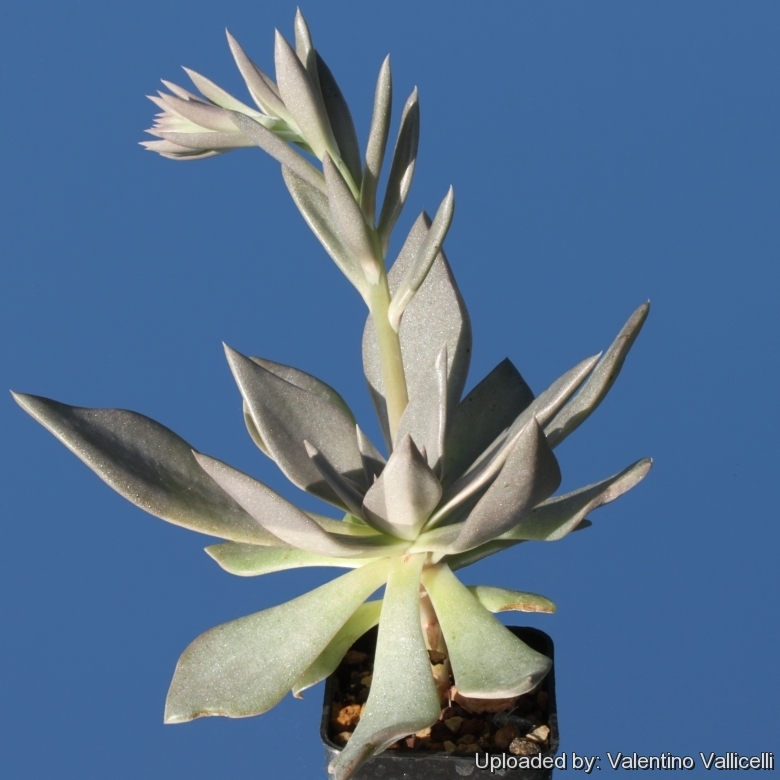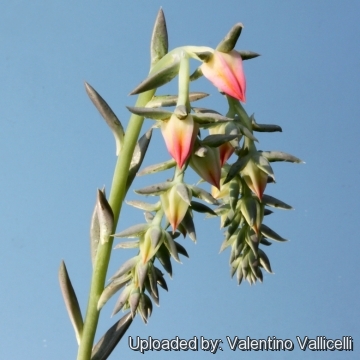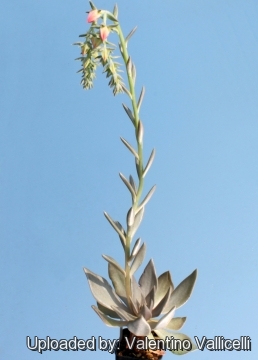Accepted Scientific Name: Echeveria bifida Schltdl.
Linnaea 13: 411 1839.

Cotyledon bifida (Echeveria bifida) Photo by: Valentino Vallicelli
Origin and Habitat: The species is native to central Mexico in the states of Guanajuato, Tamaulipas, Hidalgo and Queretaro.
Synonyms:
See all synonyms of Echeveria bifida
back
Accepted name in llifle Database:Echeveria bifida Schltdl.Linnaea 13: 411 1839.Synonymy: 3
back
Common Names include:
ENGLISH: Branched Flower Hens and Chicks
Description: Echeveria bifidaSN|25872]]SN|21872]] (Branched Flower Hens and Chicks) is a beautiful pale greyish-brown succulent plant with rosettes of fleshy leaves shaped like a well-filled spindle, slender flower stalks carry nodding bell-shaped flowers . This species is quite variable and perhaps the most difficult to characterize. Echeveria erubescensSN|21872]]SN|25872]], described from cultivation and of unknown origin in the wild probably bengs here.
Habit: It is compact plant with rosettes to 15 to 20 cm wide of up to 15 leaves.
Stem: Usually short, mostly simple.
Leaves: (3,5)5-7,5(-10) cm long, 1,2-2,5 cm wide, lanceolate, oblanceolate to diamond-shaped, pointed. Bristle-tipped pale glaucous-green, pale greyish-brown, lavender-grey or dark brown often tinged red.
Blooming season: Summer.
Inflorescence: 2-branched raceme with 20-30 florets, bracts about 3 cm long many, round in cross-section, the flowering stems rise 25-60 cm above the foliage and gracefully curve and branch with stems and bracts the same colour as the foliage..
Flowers: Large salmon pinkish-orange, with yellow throats that barely flare open near the petal tips and with succulent sepals the same color as the leaves. Sepals to 1 cm long, unequal, rigid. rounded-blunt and spreading. Corolla 1,2 cm long, pink-orange outside, yellow within. Keeled. petals joined for much of their length urn-shaped.
Chromosome number: n = 12
Bibliography: Major referencens and further lectures
1) Eric Walther “Echeveria” California Academy of Sciences, 1972
2) Hermann Jacobsen “A handbook of succulent plants: descriptions, synonyms, and cultural details for succulents other than Cactaceae, Volume 1” Blandford Press, 1960
3) Alfred Byrd Graf “Exotica, series 4 international: pictorial cyclopedia of exotic plants from tropical and near-tropic regions” Roehrs Co. Publishers, 1985
4) John Pilbeam “The Genus Echeveria” British Cactus & Succulent Society, 2008
5) James Cullen, Sabina G. Knees, H. Suzanne Cubey “The European Garden Flora Flowering Plants:A Manual for the Identification of Plants Cultivated in Europe, Both Out-of-Doors and Under Glass” Cambridge University Press, 11/ago/2011
6) Uhl, C. H. “Chromosomes and hybrids of Echeveria (Crassulaceae) VI. Series Angulatae Walther and Series Pruinosae Walther.” in: Haseltonia 6: 63–90. 98-00 12 1998.
7) Funamoto, T. & H. YUASA. “Chromosome studies in the genus Echeveria (Crassulaceae), part I. Somatic chromosome numbers of 30 species and cultivars.” in: Sci. Rep., Res. Inst. Evol. Biol. 6: 1–15. 1989.
 Cotyledon bifida (Echeveria bifida) Photo by: Valentino Vallicelli
Cotyledon bifida (Echeveria bifida) Photo by: Valentino Vallicelli Cotyledon bifida (Echeveria bifida) Photo by: Valentino Vallicelli
Cotyledon bifida (Echeveria bifida) Photo by: Valentino VallicelliCultivation and Propagation: Echeveria purpusorumSN|21880]]SN|21880]] is a summer-growing and relatively easy plant. It makes great potted specimens and is a succulent for beginning collectors.
Soil: Use a very porous soil, which will allow quick drainage.
Repotting: If potted, repot them preferably in the spring, if their roots become cramped. Generally, they should be repotted every other year in order to provide fresh soil. However, this doesn't necessarily mean they'll need larger containers. Fill about a quarter of the pot with broken crocks, gravel, etc. to promote good drainage. After repotting, do not water for a week or more. Use pot with good drainage. Eventually, as the plant becomes mature grow it slowly, and adopt a new repotting period, using intervals of every 2 - 3 years. Additionally grow it under drier conditions or with stronger sunlight.
Fertilization: Slow release fertilisers with a low to moderate nitrogen content are adequate for the spring and summer growing seasons, and additional fertiliser applications would not required until spring.
Exposure: It can tolerate sun to shade but - generally speaking - the more light a plant gets the better it will display its colours and shape. However, when moving plants from lower light conditions into full sun, be wary of sun scorch, most easily avoided by ensuring plants are well-watered before moving them on a cloudy day.
Watering: They can tolerate extended dry periods and survive drought without the need for watering, but they will grow stronger if they receive adequate moisture during their growing season, amd never allowing the plant to remain waterlogged (root rot sensitive).
Ventilation: Good air movement is important for minimising pest and disease risks, and avoiding excessive humidity in cool winter conditions is important to successfully growing Echeveria in the nursery environment.
Hardiness: It can tolerate light frosts, but it is best overwintered at 5-10 °C.
With the cooler autumn temperatures tending to make their foliage colours become more intense than those of the active summer growing season.
Pest & disease: Aphids like this plant (and all flowering Echeveria).
Propagation: Usually by seeds, but If the plant is repotted some of the bottom leaves can be removed, in order to attempt leaf propagation, it is also a common practice to collect the leaves on the flower stem. However this is not one of the easiest species to root, as many such cuttings will dry out without producing a plantlet, but with perseverance it is likely to get a few new plants.













